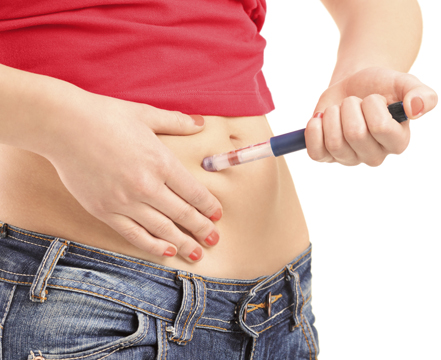When sugar's not that sweet
Diabetes is the 'Mother of all Diseases' in Sri Lanka
with 2.1 million diagnosed with the insidious condition and 2.3 million
heading there:
by Carol Aloysius
 Diabetes
is on a steep rise occupying the 8th slot among the most prevalent non
communicable diseases globally, affecting 422 million persons of both
genders. According to the World Health Organisation (WHO), high blood
sugar levels killed nearly four million persons in 2012 globally, and
are poised to escalate in the future. This is why the WHO theme for
World Health Day this year had been to 'Prevent, Treat and Beat'
diabetes which, WHO Representative in Sri Lanka, Dr Jacob Kumarasan,
described as the 'Mother of all diseases' at a media seminar last week.
Here Honorary Director National Diabetes Centre and Secretary Diabetes
Association of Sri Lanka, Dr Mahen Wijesuriya, explains WHO's concerns,
Sri Lanka's reality and the significance of lifestyle changes. Diabetes
is on a steep rise occupying the 8th slot among the most prevalent non
communicable diseases globally, affecting 422 million persons of both
genders. According to the World Health Organisation (WHO), high blood
sugar levels killed nearly four million persons in 2012 globally, and
are poised to escalate in the future. This is why the WHO theme for
World Health Day this year had been to 'Prevent, Treat and Beat'
diabetes which, WHO Representative in Sri Lanka, Dr Jacob Kumarasan,
described as the 'Mother of all diseases' at a media seminar last week.
Here Honorary Director National Diabetes Centre and Secretary Diabetes
Association of Sri Lanka, Dr Mahen Wijesuriya, explains WHO's concerns,
Sri Lanka's reality and the significance of lifestyle changes.
Q: Diabetes was the focal subject of discussion on World
Health Day observed early this week. Do you see a sharp increase in the
disease compared to a few years ago?
A: The prevalence rate is 10.3% for the over 20-year
population, which is 2.1 million. In addition there are 2.3 million
persons who have pre-diabetes. This makes a grand total of 4.4 million
persons who have dysglycaemia (Diabetes + pre diabetes) in Sri Lanka.
This figure shows 1 in 5 persons have abnormal blood sugar levels in
the country, with the figures likely to go up in the near future.
The sharp increase compared to a few years ago is occurring in the
urban and rural areas and has now reached 16% urban and 8% rural. In the
under 20-year category, in the urban sector, dysglycaemia is over 8.2%
according to a research study in 2013 done by the Diabetes Association
of Sri Lanka.
Q:Reasons?
A:Lifestyle changes, no proper nutrition, inadequate exercise,
stress associated with urbanisation, high aspirations, and weight gain.
Lifestyle change is the most direct cause for diabetes.
|

Diabetic Wound |
Q:Has the average high risk groups age-wise for diabetes also
changed compared to the past?
A: What was once an over 40-year high risk now encompasses all
ages, especially Type 2 Diabetes, which has cut across all age groups.
Q: Early indications of diabetes?
A: Fifty per cent of those with diabetes are unaware they have
diabetes as they have no symptoms. Early indications include: weight
loss, increased urination, increased thirst, delay in wound healing,
altered vision, altered sensation in the feet, numbness, tingling and
cramps... to mention a few important ones. When these are present, it
should be followed up by blood sugar estimations: 100mg% before meals
and less than 140 mg% 2 hours after a meal is the international standard
we follow.
Q:What is the most common diabetic type prevalent in Sri
Lanka?
A: 95% of diabetics have type 2 diabetes.
Q:Which organs of the body are most affected by diabetes?
A: Heart, brain, kidney, eyes and feet. Diabetes affects
organs through a reduction in blood flow, which is often associated with
abnormal fat deposition secondary to increase in cholesterol levels and
hypertension.
|

Dr Mahen Wijesuriya |
| New device to
treat foot problems -Diabetiologist and Honorary Consultant
Dr S. Salie
A new technology is available for the
first time in Sri Lanka to help diabetic patients with foot
problems, even while they are seated. Using a simple device,
they can improve their circulation much faster, in a seated
position. This device has been able to stop amputations,
provide relief from venous insufficiencies, eliminate
symptoms due to diabetic neuropathy, faster than
conventional treatment methods, and increase blood flow in
patients with PVD (healing diabetic ulcers) If they do these
foot exercises with this device while seated, it's like
climbing 2225 steps up a stairway and the blood circulation
will flow so that patients will be able to feel the floor
with their feet for the first time. Several studies in the
US as well as our own feed back from our patients, prove
this," he told the Sunday Observer.
For more information, contact
[email protected] |
Q: Is diabetes curable?
A: No. It can only can be controlled or managed through
treatment and lifestyles. Hence it should be prevented from an early
age.
Q:How?
A: Adequate nutrition at all ages from gestation upwards to
prevent under nutrition in the womb and over nutrition after birth is
the key. Exercise a minimum of 30 min per day. Stress control, often
ignored, is another essential component in preventing diabetes.
Q:Many pregnant women are reported as having diabetes or in a
pre-diabetic condition? What is the cause?
A: Same causes for Type 2 diabetes: Genetics, fetal origins,
lifestyles and stress. All these factors pre dispose a woman to develop
diabetes in pregnancy with an additional input of placenta hormones and
their ill effects.
Q: Several school going children have been reported as being
pre-diabetics. Is this true?
A: 8.2% under 18-year-olds in Sri Lanka have pre- diabetes,
caused by the same predisposing factors, namely
wrong eating habits such as increase in sugar consumption, refined
starches and fats, together with reduced exercise due to pressure of
education (tuition) which minimises the available time for children to
play. Stress due to pressure of parents for the child to excel in their
studies beyond their ability is one of the main causes
Q: How much sugar do you recommend in our daily diet?
A: WHO recommends reducing 10% of total calorie intake. In Sri
Lanka an average 9- 10 tsp of sugar is consumed per day. Recommendation
is that you reduce this to 5 -6 tsp per day.
| New techniques in
treating diabetics - Chartered Physiotherapist Dr Gopi
Kitnasamy
Diabetic ulcers: People with advanced
diabetes have a diminished perception of pain in the
extremities due to nerve damage, and therefore may not
initially notice small scratches or bruises on their legs
and feet. Diabetes also impairs the immune system and
damages capillaries. Repeated injury, compounded by impaired
healing, can cause even the smallest cut or bruise to become
dangerously infected.
Laser therapy - i.e. Light Amplification
by Stimulated Emission of Radiation has been used to treat
ulcers, pressure sores, infected wounds, burns, traumatic
wounds and postoperative wounds that are failing to heal. It
results in improved tissue repair, faster resolution of the
inflammatory response, and reduction of pain. |
|
On a preventive
mission
The Health Ministry has also initiated
several programs to reduce diabetes. Speaking at the Health
Education Bureau last week, Director Non Communicable
Diseases Unit, Dr Thilak Siriwardene said 817 Healthy Life
Styles Centres for normal persons to get free body checks
have been set up islandwide. To find out their nearest
healthy life styles centre they can telephone 2669599 from
anywhere in the island.
Director General Health Services Dr P.G.
Mahipala said all in- house patients in state hospitals were
now being served diabetic diets and circulars had been sent
to all eating outlets to serve sugar in separate bowls.
"We are also promoting the concept of
eating more green vegetables and fruits and maintaining Body
Mass Index at the correct level, Consultant Endocrinologist
& Diabetetologist Dr Prasad Katulanda said, stressing that
engaging in active physical exercise can prevent diabetes
than rather than sitting in front of a computer. |
Q: What is the ideal diet for diabetics based on foods we grow
locally?
A: Quality quantity and timing are the mantra here for healthy
living. Whole grain products such as 'mung', cowpea, gram, 'kadala' and
minimally milled rice (red rice) high bran flour products - such as red
rice, atta, kurkkan, uludu, ruling, soya with reduced sugars and refined
starches such as white flour, bread and bread products. (High quality
brown bread may be considered) and fats. Commercial products such as
bread and buns should be avoided.
Fruits and vegetables are highly recommended. Dairy products for a
growing child should be full cream . For those over 20, fat content
should be restricted.
Fish and white meat (chicken) is preferred to red meat, which has
excess fat.
Q:Quantity?
A: Should be restricted to maintain ideal body weight
according height in keeping with needs of growth in a child or
pregnancy. You can check the BMI in www schoolnet.org / health
Q:Timing?
A: This is another important aspect often ignored when
consuming meals. Spread regular meals throughout the day in equitable
portions without delay as the latter leads to excessive hunger leading
to unbalanced consumption at different times of the day.
No child should leave home without eating.
A wholesome snack should be sent for mid day (10.30 -11 a.m.) from
home; lunch and dinner should be followed.
Meal pattern for a school going child should be four small meals
given at 7a.m , 11a.m, 3p/m and 7 p/m. ideally, with food prepared at
home. |

